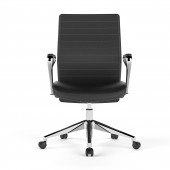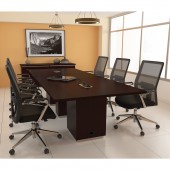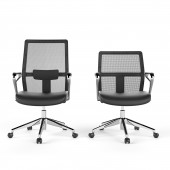DESIGN NAME:
Aventi
PRIMARY FUNCTION:
Office chair for multi-taskers
INSPIRATION:
The Aventi chair is designed to be minimalist in appearance. The features and controls have been discreetly integrated to visually create a serene look.
UNIQUE PROPERTIES / PROJECT DESCRIPTION:
A unique chair designed to look good and be suitable in multiple office settings: sitting forward at a computer desk, reclining to browse on a cell phone, working at a reception desk or teleconferencing in a meeting room.
The chair offers two backrest options: leather upholstery or screen mesh.
Features: custom molded foam for the seat & backrest upholstery; adjustable lumbar support for the screen backrest; self- adjusting reclining mechanism; die cast polished aluminum armrests and base.
OPERATION / FLOW / INTERACTION:
The chair uses a self-adjusting mechanism, meaning the user's own weight serves as tension when reclining. There is no need to manually adjust the tension.
PROJECT DURATION AND LOCATION:
Project started in Ontario, California, USA in 2013 and finished in 2015. Project was exhibited in Chicago in June 2015.
FITS BEST INTO CATEGORY:
Furniture Design
|
PRODUCTION / REALIZATION TECHNOLOGY:
Highly recyclable chair made of:
Die cast polished aluminum arm & base
Plywood seat & back shells
Molded foam
Steel mechanism
Nylon casters
Recycled leather
SPECIFICATIONS / TECHNICAL PROPERTIES:
Overall dimensions: 57cm wide x 60cm deep x 108cm high
TAGS:
timeless, clean, modern, discreet
RESEARCH ABSTRACT:
Research first focused on creating a unique look for a new office chair using hand sketches, 3D digital models and hand made mock ups. Once a final design was chosen, an accurate 3D digital model was built using the latest data in human ergonomics. Secondly several functional prototypes were made and put to tests. Lastly, a close collaboration with the manufacturer was done to obtain the best production quality in the most efficient way.
CHALLENGE:
The simple yet unique shape of the aluminum arm challenged us on how to attach a soft pad without having visible hardware and on how to polish the inside of the arm. Both challenged were resolved successfully: a tapered indentation allows to hide the hardware for the arm pad; a smaller buffing wheel gave us access for polishing the armrest's inner portion.
ADDED DATE:
2017-04-06 22:08:03
TEAM MEMBERS (2) :
Rick Blumenthal, owner and Julien Egger, designer
IMAGE CREDITS:
Julie Egger
PATENTS/COPYRIGHTS:
US Design Patent awarded for the Arm:
US D774,343 S, Blumenthal Distributing Inc., Inventor: Julien Egger, Dec. 20, 2016
|










